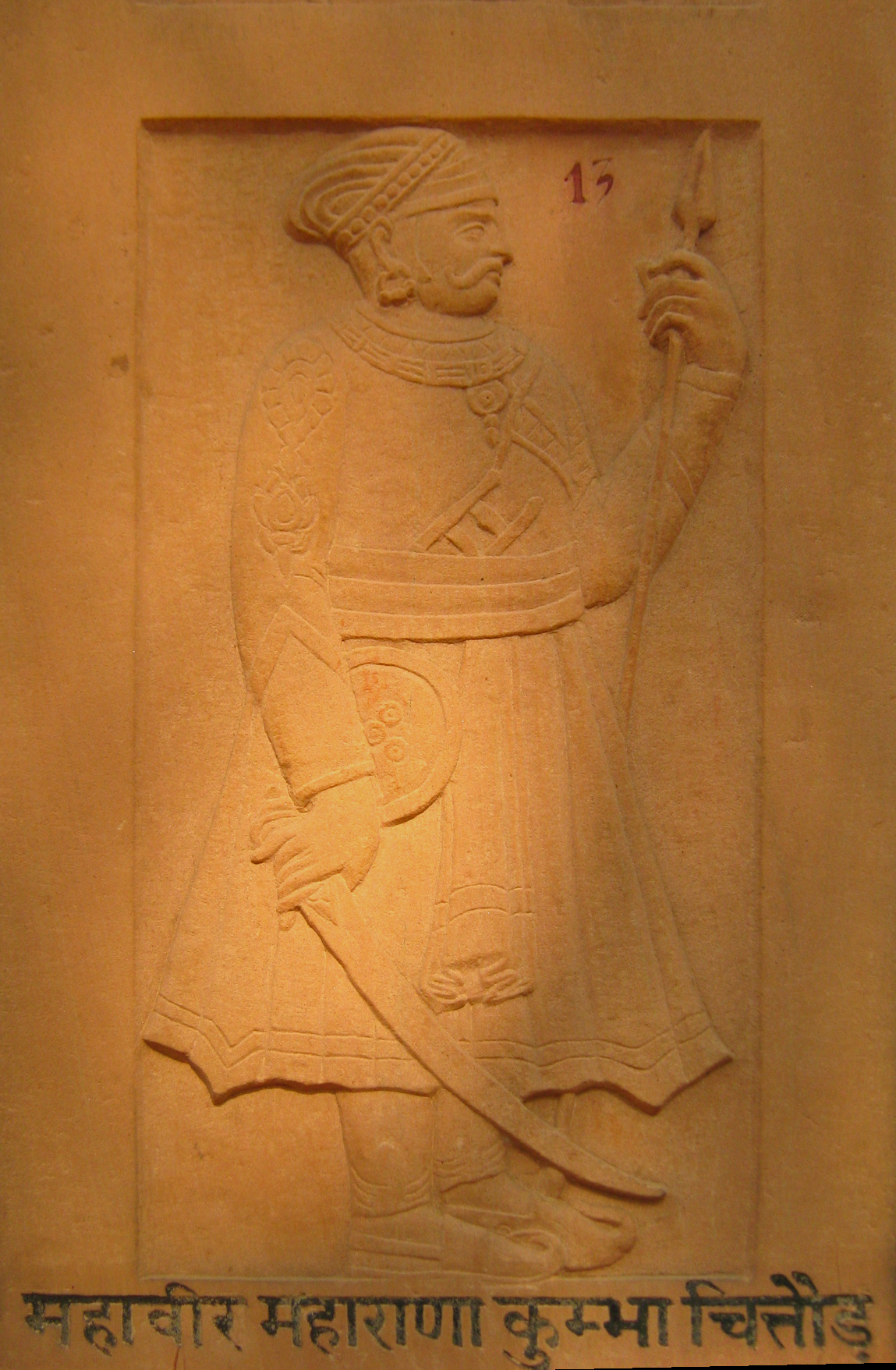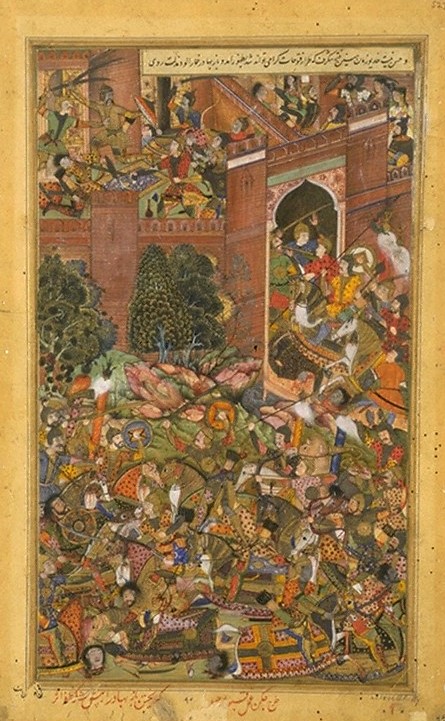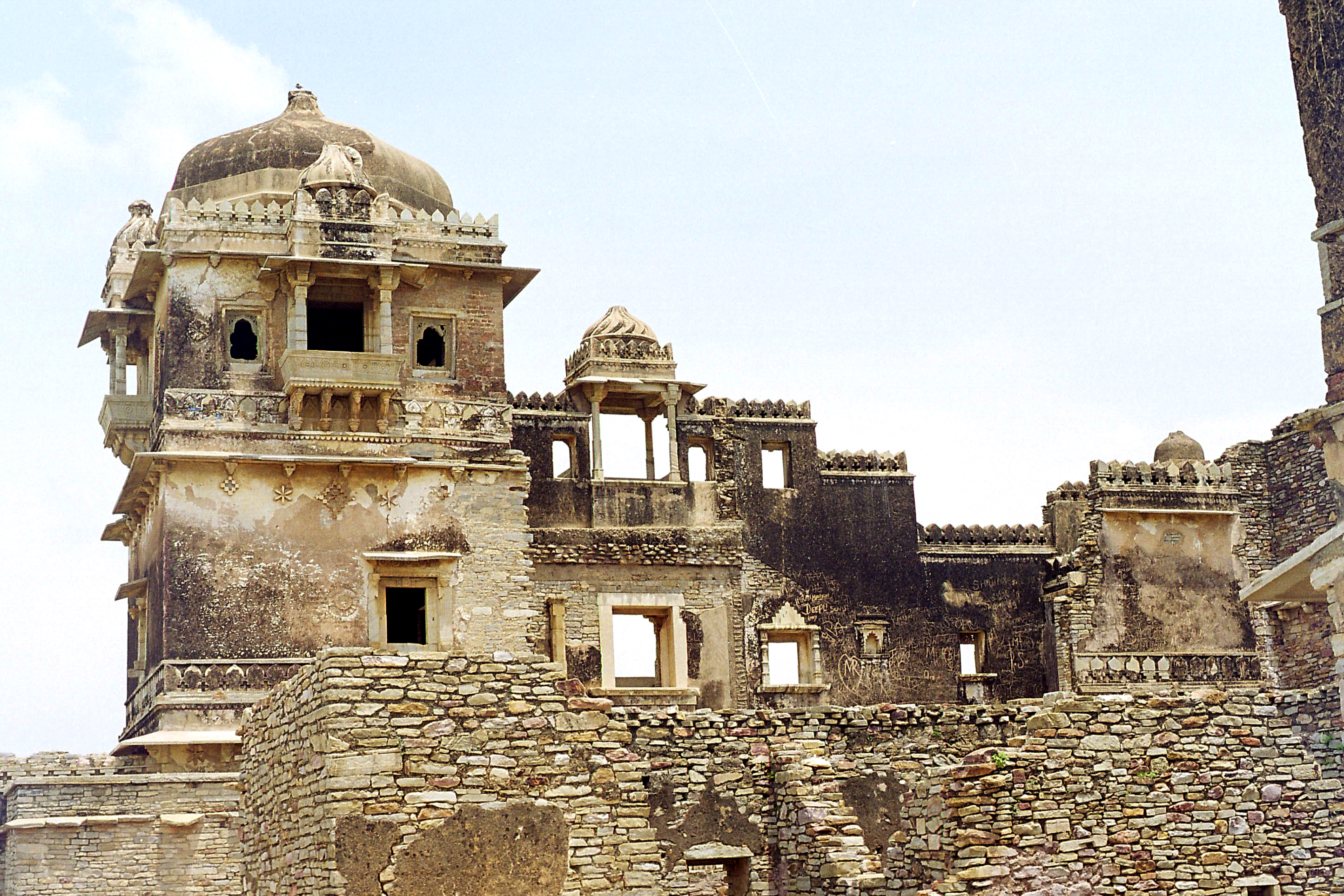|
Chunda Sisodia
Chunda was the eldest son of Maharana Lakha, the ruler of Mewar. He is known in history for his sacrifice of his rights to the throne, to keep his promise. He was the heir-apparent until he renounced his right in favour of the heir born from Hansa Bai, the Rathore princess who was married to Maharana Lakha. Early life Chunda, was the eldest out of eight issues of Rao Lakha. Ranmal Rathore, the eldest son of Rao Chunda of Marwar was discontented with his fate in Mandore, as his father made Kanha as the heir apparent. He arrived in Mewar, where Rana Lakha granted him the jagir of Dhanla. Ranmal sent a marriage proposal of his sister Hansa Bai to the heir apparent of Mewar, but when the proposal arrived in the court, Rana Lakha jested with the delegation, remarking the proposal was obviously not for him. Chunda, who was on a mission then, was absent from the court. On his return, Chunda came to know that the whole event, he rejected the offer. To avoid making an issue by returnin ... [...More Info...] [...Related Items...] OR: [Wikipedia] [Google] [Baidu] |
Mokal Singh
Mokal or Mokal Singh ( & ), was the Maharana of Mewar Kingdom. He was a son of Maharana Lakha Singh. Maharana Mokal has been described as a great builder, a trait which he had inherited from his father. He created various buildings along with completing those commenced by his father Lakha. He renovated Temple of Samadhishvar, which was built by King Bhoja Parmar, thus it is also called Mokal Ji Ka Mandir. History of Mewar, R V Somani, 1976, p120 Background Mokal was a younger son of Lakha Singh and was born of his wife Hansa bai, a princess of Jodhpur State, Mandore. His mother was not originally betrothed to his father, but rather to Lakha's eldest son Prince Chunda Sisodia. When the delegation from Mandore had arrived in Chittor to officialise the betrothal, Chunda was away from court. The ageing Lakha jested with the delegation, remarking that the proposal was obviously not meant for a "greybeard" like him. When Chunda later learned of the comment, the proud prince refuse ... [...More Info...] [...Related Items...] OR: [Wikipedia] [Google] [Baidu] |
Chundawat
Chundawats are a Rajput clan and were powerful chiefs in the Mewar region during the 1700s. They are the descendants of the 15th century Mewari prince Chunda Sisodia, the eldest son of Rana Lakha. Having surrendered his right to the throne to his younger brother Mokal Singh Mokal or Mokal Singh ( & ), was the Maharana of Mewar Kingdom. He was a son of Maharana Lakha Singh. Maharana Mokal has been described as a great builder, a trait which he had inherited from his father. He created various buildings along wi ..., Chunda gained for his descendants the right to advise the reigning Rana on matters of State as well as an exalted position on the royal council. References {{Rajput Groups of India Rajput clans of Rajasthan ... [...More Info...] [...Related Items...] OR: [Wikipedia] [Google] [Baidu] |
Sisodia
The Sisodia is an Indian Rajput dynasty belonging to the clan that ruled over the kingdom of Mewar in Rajasthan. The name of the clan is also transliterated as ''Sesodia'', ''Shishodia'', ''Sishodia'', ''Shishodya'', ''Sisodya'', ''Sisodiya'', ''Sisodia''. Origins The Sisodia dynasty traced its ancestry to Rahapa, a son of the 12th century Guhila King Ranasimha. He founded the village of Shisoda, in modern day Rajsamand district, as his capital, after which his descendants were called Sisodias. The main branch of the Guhila dynasty ended with their defeat against the Khalji dynasty at the Siege of Chittorgarh (1303). In 1326, Rana Hammir, who belonged to Sisodiya branch, reclaimed control of the region, re-established the dynasty, and also became the founder of the Sisodia dynasty clan, a branch of the Guhila dynasty, to which every succeeding Maharana of Mewar belonged, and the Sisodias regained control of Chittor, the former Guhila capital.''The Rajputs of Rajputana: a gl ... [...More Info...] [...Related Items...] OR: [Wikipedia] [Google] [Baidu] |
Lakha Singh
Rana Lakha (1382 – 1421) was a king belonging to the Sisodia lineage of Mewar in present-day state of Rajasthan. He was the son of Maharana Kshetra Singh and ruled from 1382 until his death in 1421. Lakha was married several times and had at least eight sons. His son Mokal Singh by his wife Hansa Bai of Mandore (now in Jodhpur) became the fourth Maharana in 1421. During his reign, Lakha took the remaining Mewar territories from Delhi. His eldest son Chunda took oath to safeguard his motherland against all external powers who were trying to overpower the Mewar state in the exchange of his father's marriage to Rani Hansa Bai. After having some misunderstanding with Rani Hansa Bai and Rao Ranmal (brother of Rani Hansa Bai) Rana Chunda left the Chittorgarh fort and went to fort Begu in Chittorgarh district and ruled there himself. The followers of Chunda are known as Chundawats. Rule Rana Lakha Singh was one of the most successful Maharana's. He extended his dominions by the s ... [...More Info...] [...Related Items...] OR: [Wikipedia] [Google] [Baidu] |
Mewar
Mewar or Mewad is a region in the south-central part of Rajasthan state of India. It includes the present-day districts of Bhilwara, Chittorgarh, Pratapgarh, Rajsamand, Udaipur, Pirawa Tehsil of Jhalawar District of Rajasthan, Neemuch and Mandsaur of Madhya Pradesh and some parts of Gujarat. For centuries, the region was ruled by Rajputs. The princely state of Udaipur emerged as an administrative unit during the period of British East India Company governance in India and remained until the end of the British Raj era. The Mewar region lies between the Aravali Range to the northwest, Ajmer to the north, Gujarat and the Vagad region of Rajasthan to the south, the Malwa region of Madhya Pradesh state to the south and the Hadoti region of Rajasthan to the east. Etymology The word "Mewar" is vernacular form of "Medapata" ( IAST: Medapāṭa), the ancient name of the region. The earliest epigraph that mentions the word "Medapata" is a 996–997 CE (1053 VS) inscription discovered ... [...More Info...] [...Related Items...] OR: [Wikipedia] [Google] [Baidu] |
Lakha Singh
Rana Lakha (1382 – 1421) was a king belonging to the Sisodia lineage of Mewar in present-day state of Rajasthan. He was the son of Maharana Kshetra Singh and ruled from 1382 until his death in 1421. Lakha was married several times and had at least eight sons. His son Mokal Singh by his wife Hansa Bai of Mandore (now in Jodhpur) became the fourth Maharana in 1421. During his reign, Lakha took the remaining Mewar territories from Delhi. His eldest son Chunda took oath to safeguard his motherland against all external powers who were trying to overpower the Mewar state in the exchange of his father's marriage to Rani Hansa Bai. After having some misunderstanding with Rani Hansa Bai and Rao Ranmal (brother of Rani Hansa Bai) Rana Chunda left the Chittorgarh fort and went to fort Begu in Chittorgarh district and ruled there himself. The followers of Chunda are known as Chundawats. Rule Rana Lakha Singh was one of the most successful Maharana's. He extended his dominions by the s ... [...More Info...] [...Related Items...] OR: [Wikipedia] [Google] [Baidu] |
Mandu, Madhya Pradesh
Mandu or Mandavgad is an ancient city in the present-day Mandav area of the Dhar district. It is located in the Malwa and Nimar region of western Madhya Pradesh, India, at 35 km from Dhar city. In the 11th century, Mandu was the sub division of the Tarangagadh or Taranga kingdom. This fortress town on a rocky outcrop about from Indore is celebrated for its architecture. History An inscription discovered from Talanpur (around 100 km from Mandu) states that a merchant named Chandra Simha installed a statue in a temple of Parshvanatha located in the Mandapa Durg. While "Durg" means "Fort", the word "Mandu" is a Prakrit corruption of "''mandapa''", meaning "hall, temple". The inscription is dated 612 VS (555 CE), which indicates that Mandu was a flourishing town in 6th century. Mandu gained prominence in 10th and 11th century under the Paramaras. The town of Mandu, situated at an elevation of 633 metres (2,079 feet), is perched on the Vindhya Range ext ... [...More Info...] [...Related Items...] OR: [Wikipedia] [Google] [Baidu] |
Rana Kumbha
Kumbhakarna Singh (r. 1433–1468 CE), popularly known as Maharana Kumbha, was the Maharana of Mewar kingdom in India. He belonged to the Sisodia clan of Rajputs. Rana Kumbha is known for his illustrious military career against various sultanates and patronization of art and music and architecture. Early life Rana Kumbha was born at Madariya, in a Hindu Rajput family of Sisodia clan. Kumbha was a son of Rana Mokal Singh of Mewar by his wife, Sobhagya Devi, a daughter of Jaitmal Sankhla, the Paramara fief-holder of Runkot in the state of Marwar. He was the 48th Rana of Mewar and succeeded Rana Mokal Singh in the year 1433 CE as the ruler of Mewar. Early period After being overrun by the armies of Alauddin Khalji at the turn of the 13th century, Mewar had become relatively insignificant. Rana Hammira is credited with casting off the Turkic yoke and establishing the second Guhila dynasty of Chittor in 1335. The title ''Rana'', and later ''Maharana'', were used by rulers of ... [...More Info...] [...Related Items...] OR: [Wikipedia] [Google] [Baidu] |
Mandore
Mandore is a suburb Historical town located 9 km north of Jodhpur city, in the Indian state of Rajasthan. History Mandore is an ancient town, and was the seat of the Pratiharas of Mandavyapura, who ruled the region in the 6th century CE. Even after the disintegration of the Gurjara-Pratihara empire, a Pratihara family continued to rule at Mandore. This family formed an alliance with the Rathore chief Rao Chunda (r. c. 1383-1424) to defend its chiefdom against the Tughluq dynasty of the Delhi Sultanate. Rao Chunda married a Pratihara princess of Mandore, and received the Mandore Fort in dowry; the Fort served as his family's capital until 1459 CE, when Rao Jodha shifted it to the newly-founded city of Jodhpur. Rao Ranmal Rathore secured the throne of Mandore in 1427. In addition to ruling Mandore, Rao Ranmal also became the administrator of Mewar to assist Maharana Mokal (father of Rana Kumbha). After the assassination of Maharana Mokal in 1433, Ranmal continued as admin ... [...More Info...] [...Related Items...] OR: [Wikipedia] [Google] [Baidu] |
Kumbha Of Mewar
Kumbhakarna Singh (r. 1433–1468 CE), popularly known as Maharana Kumbha, was the Maharana of Mewar kingdom in India. He belonged to the Sisodia clan of Rajputs. Rana Kumbha is known for his illustrious military career against various sultanates and patronization of art and music and architecture. Early life Rana Kumbha was born at Madariya, in a Hindu Rajput family of Sisodia clan. Kumbha was a son of Rana Mokal Singh of Mewar by his wife, Sobhagya Devi, a daughter of Jaitmal Sankhla, the Paramara fief-holder of Runkot in the state of Marwar. He was the 48th Rana of Mewar and succeeded Rana Mokal Singh in the year 1433 CE as the ruler of Mewar. Early period After being overrun by the armies of Alauddin Khalji at the turn of the 13th century, Mewar had become relatively insignificant. Rana Hammira is credited with casting off the Turkic yoke and establishing the second Guhila dynasty of Chittor in 1335. The title ''Rana'', and later ''Maharana'', were used by rulers of ... [...More Info...] [...Related Items...] OR: [Wikipedia] [Google] [Baidu] |
Chittorgarh Fort
The Chittorgarh (literally Chittor Fort), also known as Chittod Fort, is one of the largest forts in India. It is a UNESCO World Heritage Site. The fort was the capital of Mewar and is located in the present-day city of Chittorgarh. It sprawls over a hill in height spread over an area of above the plains of the valley drained by the Berach River. The fort covers 65 historic structures, which include four palaces, 19 large temples, 20 large water bodies, 4 memorials and a few victory towers. In 2013, at the 37th session of the World Heritage Committee held in Phnom Penh, Cambodia, Chittorgarh Fort, along with five other forts of Rajasthan, was declared a UNESCO World Heritage Site, as a group called the Hill Forts of Rajasthan. Geography Chittorgarh, located in the southern part of the state of Rajasthan, from Ajmer, midway between Delhi and Mumbai on the National Highway 8 (India) in the road network of Golden Quadrilateral. Chittorgarh is situated where National Highways No. ... [...More Info...] [...Related Items...] OR: [Wikipedia] [Google] [Baidu] |
Salumbar
Salumbar is a statutory town in Udaipur district in the Indian state of Rajasthan. Geography Salumbar is located at . It has an average elevation of 262 metres (859 feet). Demographics India census, Salumbar had a population of 16,425 of which 8,420 are males while 8,005 are females. The Female Sex Ratio in Salumbar Municipality stood as 951, against the state average of 928. Salumbar city had a Literacy rate of 85.82%, which was higher than the state average of 66.11%. Male literacy was 93.78%, and female literacy was 77.56%. There are around 3,390 houses under the Salumbar Municipality administration, where it supplies basic amenities like water and sewerage. Earlier in 2001, India census A census is the procedure of systematically acquiring, recording and calculating information about the members of a given population. This term is used mostly in connection with national population and housing censuses; other common censuses incl ..., Salumbar had a population ... [...More Info...] [...Related Items...] OR: [Wikipedia] [Google] [Baidu] |




_at_Mandore_Garden.jpg)

